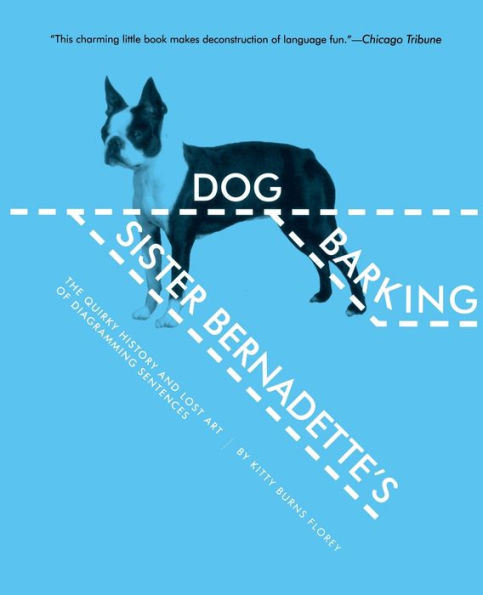A SLATE BEST BOOK OF THE YEAR
A PEOPLE PICK FOR WORD LOVERS
“This gem from copyeditor Florey is a bracing ode to grammar.”—People
In its heyday, sentence diagramming was wildly popular in grammar schools across the country. Kitty Burns Florey learned the method in sixth grade from Sister Bernadette: "It was a bit like art, a bit like mathematics. It was a picture of language. I was hooked.”
Now, in Sister Bernadette's Barking Dog, an offbeat history that any language lover will adore, Florey explores the sentence-diagramming phenomenon and what diagrams of famous writers' sentences reveal about them.
Along the way, she offers up her own commonsense approach to learning and using good grammar. And she answers some of literature's most pressing questions: Was Mark Twain or James Fenimore Cooper a better grammarian? Can knowing how to diagram a sentence make your life better? And what's Gertrude Stein got to do with any of it?
“A pleasantly discursive and affectionate tribute to an antiquated art.”—The Wall Street Journal
“You don't have to be over age 50 or a Catholic school graduate to enjoy Sister Bernadette's Barking Dog . . . Florey's keen memories of being schooled in this art and her humorous affection for it are contagious . . . Try it, you’ll like it."—Minneapolis Star Tribune
"Florey writes with verve about the nuns who taught her to render the English language as a mess of slanted lines, explains how diagrams work, and traces the bizarre history of the men who invented this odd pedagogical tool . . . It’s a great read."—Slate
KITTY BURNS FLOREY , a veteran copyeditor, is the author of nine novels and many short stories and essays. A longtime Brooklyn resident, she now divides her time between central Connecticut and upstate New York with her husband, Ron Savage.
A SLATE BEST BOOK OF THE YEAR
A PEOPLE PICK FOR WORD LOVERS
“This gem from copyeditor Florey is a bracing ode to grammar.”—People
In its heyday, sentence diagramming was wildly popular in grammar schools across the country. Kitty Burns Florey learned the method in sixth grade from Sister Bernadette: "It was a bit like art, a bit like mathematics. It was a picture of language. I was hooked.”
Now, in Sister Bernadette's Barking Dog, an offbeat history that any language lover will adore, Florey explores the sentence-diagramming phenomenon and what diagrams of famous writers' sentences reveal about them.
Along the way, she offers up her own commonsense approach to learning and using good grammar. And she answers some of literature's most pressing questions: Was Mark Twain or James Fenimore Cooper a better grammarian? Can knowing how to diagram a sentence make your life better? And what's Gertrude Stein got to do with any of it?
“A pleasantly discursive and affectionate tribute to an antiquated art.”—The Wall Street Journal
“You don't have to be over age 50 or a Catholic school graduate to enjoy Sister Bernadette's Barking Dog . . . Florey's keen memories of being schooled in this art and her humorous affection for it are contagious . . . Try it, you’ll like it."—Minneapolis Star Tribune
"Florey writes with verve about the nuns who taught her to render the English language as a mess of slanted lines, explains how diagrams work, and traces the bizarre history of the men who invented this odd pedagogical tool . . . It’s a great read."—Slate
KITTY BURNS FLOREY , a veteran copyeditor, is the author of nine novels and many short stories and essays. A longtime Brooklyn resident, she now divides her time between central Connecticut and upstate New York with her husband, Ron Savage.

Sister Bernadette's Barking Dog: The Quirky History and Lost Art of Diagramming Sentences
176
Sister Bernadette's Barking Dog: The Quirky History and Lost Art of Diagramming Sentences
176Paperback(First Edition)
Related collections and offers

Product Details
| ISBN-13: | 9780156034432 |
|---|---|
| Publisher: | Houghton Mifflin Harcourt |
| Publication date: | 11/05/2007 |
| Edition description: | First Edition |
| Pages: | 176 |
| Sales rank: | 79,724 |
| Product dimensions: | 7.12(w) x 8.50(h) x 0.46(d) |
About the Author
Customer Reviews
Explore More Items
If you’ve got incredible iOS ideas, get this book and bring them to life!
iOS 7 represents the most significant update to Apple’s mobile operating system since the first iPhone was
Nothing seems to change faster than an iPhone. Just when you think you know your way around the device, a new update arrives and you
We all love good food, and the fresher it is, the better! And what could be fresher than farm-to-table terms than vegetables you've grown at home? The
So, you want to begin an intermittent fasting plan and embark on a leaner, healthier and longer life? You probably have
"Sweeping, erudite, sharply argued, and fun to
In this Pulitzer Prize finalist and national bestseller, one of the world's leading cognitive scientists
A provocative history of violence—from the New York
Pagford is, seemingly, an English idyll, with a cobbled market square and an
This edition of Harry Potter and the Prisoner of Azkaban has a gorgeous new cover illustration by Kazu Kibuishi. Inside is the full text of the original novel, with decorations by Mary
This special edition of Harry Potter and the Order of the Phoenix has a gorgeous new cover illustration by Kazu Kibuishi. Inside is the full text of the original novel, with decorations by Mary
